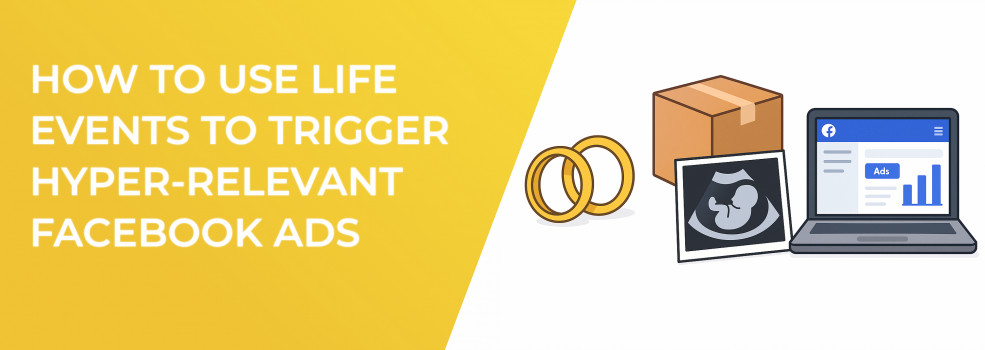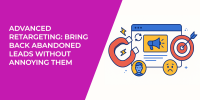Facebook’s targeting engine has evolved far beyond simple demographics. Hidden inside Meta Ads Manager is a powerful category called Life Events, moments like “Just got engaged,” “Moved to a new city,” or “Started a new job.” When you align messaging with these milestones and pair them with disciplined Facebook ad optimization tactics, your campaigns stop interrupting strangers and start delivering timely, helpful content.
Below is a practical, performance-focused playbook for turning life‑event data into revenue‑driving campaigns that feel genuinely relevant while boosting overall Facebook ad performance.
Why Life‑Event Targeting Supercharges Performance
When people move, get promoted, or celebrate an anniversary, their purchase intent spikes. Targeting those moments unlocks three core benefits:
Higher engagement – Brands often register a 20–40 percent lift in CTR Facebook, with the average click‑through rate on Facebook ads climbing above three percent.
Better efficiency – Relevance rises, driving down both the average cost per click Facebook and the total cost of advertising Facebook.
Faster learning – Fresh conversions arrive quickly, helping ad sets exit the learning phase sooner and improving overall Facebook ads optimization. These tight windows also help campaigns exit the learning phase faster — see How to Finish the Facebook Learning Phase Quickly for a full checklist.
Life-event audiences typically lift CTR and lower CPC versus standard interest targeting.
Mastering these benefits starts with knowing which life events matter most to your brand and understanding how Meta classifies them.
The Building Blocks: What Counts as a “Life Event”?
You’ll find dozens of milestones under Detailed Targeting, but not all of them are equally useful for advertisers. Before diving in, think about your product’s natural buying triggers and map those triggers to the categories below. Doing this quick exercise up front prevents wasted spend later.
Relationship milestones – Engaged, Newly Married, Anniversary within 30 days
Family growth – Expecting a Baby, New Parents, Parents with Teens
Career or relocation – Recently Moved, New Job, College Graduation
Seasonal moments – Upcoming Birthday, Recently Traveled, New Vehicle Owner
Selecting the shortest recency window (often 90 days) keeps messaging timely and prevents wasted impressions. If you’re new to audience building, start with our Facebook Ad Targeting 101 guide before experimenting with life-event filters.
Step‑by‑Step: Creating a Life‑Event Audience
Audience set‑up is where many campaigns go sideways. Rushing through this stage can create overlapping or under‑sized segments that never leave the learning phase. Slow down and follow the checklist below.
Open Ads Manager → Audiences → Create New Saved Audience.
In Detailed Targeting, click Browse → Demographics → Life Events.
Choose the milestone that fits your offer, for example, “Anniversary within 30 days.”
Layer for context with age, income, or behaviors to sharpen relevance.
Exclude overlaps by removing existing customers through Custom Audiences built with your Facebook Pixel data.
Save the audience with a descriptive name such as “NYC Newly Engaged • 90 Days.”
Finding Life Events in Ads Manager is just two clicks away, no advanced setup required.
Once you’ve finished, allocate budgets with campaign budget optimization so the algorithm can find the top performer and lift key Facebook ad metrics. A well‑structured audience saves hours of troubleshooting down the road.
Crafting Creative That Resonates
Your audience is only half the battle; creative must speak to the moment. Before you build ads, write down what the user might be feeling and the most urgent problem you can solve. Use that insight as your north star.
Speak to the milestone – A headline such as “Just said yes? Let’s plan the reception” beats generic offers every time.
Show visual empathy – Lifestyle images that match the event — moving boxes, engagement rings, ultrasound photos — feel organic in feed.
Offer a fast next step – Checklists, quizzes, or discount codes reduce friction and boost the Facebook ads conversion rate.
Refresh often – Churn is high, so rotate creatives every two to four weeks to sustain ad impressions Facebook and maintain a strong relevance score Facebook ads.
For example, an engagement audience might receive a venue‑tour incentive, a new‑job segment could see a commuter‑backpack bundle, parents‑to‑be might welcome a diaper‑subscription discount, and recent movers could respond to a limited‑time offer on custom wall art. Pair life‑event targeting with smart frequency capping to avoid fatigue—our article on How Frequency Capping Helps Beat Facebook Ad Fatigue explains how.
Quick hook ideas to spark concepts:
-
Engagement – celebrate with a venue-tour incentive.
-
New Job – showcase a commuter-backpack bundle.
-
New Baby – spotlight a diaper-subscription discount.
-
Recently Moved – promote a limited-time offer on custom wall art.
Measuring What Matters
Many advertisers obsess over vanity metrics, but life‑event campaigns live or die by three numbers:
Track these three metrics to measure the true impact of your life-event campaigns — efficiency, engagement, and delivery strength.
Cost per Result – Aim for 10–30 percent below your account average to prove segment efficiency.
Conversion Rate – Target two‑to‑three times your non‑life‑event ads to confirm message‑moment fit.
Quality Ranking – Strive for Above Average or higher to protect CPMs and lift overall Facebook ads performance metrics.
If results stall, run the diagnostics in Facebook Ads Not Converting: How to Fix It before changing your audience. Small tweaks often restore momentum faster than a full reset.
Avoid Common Pitfalls
Even skilled media buyers stumble when first testing life‑event audiences. Keep these red flags on your radar:
Stuck on “Ad Set May Get Zero”? Check Understanding Facebook Ad Statuses for quick fixes.
Overly broad time frames – Couples engaged eleven months ago likely finished ring shopping; keep recency tight.
Single‑ad fatigue – One creative variant kills scale. Launch at least three to five versions per milestone to keep Facebook ads creative fresh.
Neglecting mobile placements – Most life‑event browsing happens on phones. Test Reels and Stories early for low‑cost reach.
Addressing these issues early prevents wasted budget and protects long‑term performance.
Putting It All Together
Life events are not just social updates; they’re high‑intent purchase signals that surface daily inside Meta’s ecosystem. Align your targeting, creative, and measurement around these milestones, follow sound Facebook ads best practices, and watch relevance soar while costs fall.
Start with one thoughtfully built life‑event audience, launch multiple creatives, and let the data guide your next move. Soon, your ads will feel less like interruptions and more like timely, useful suggestions, delivering Facebook ad performance that delights both stakeholders and customers alike.

